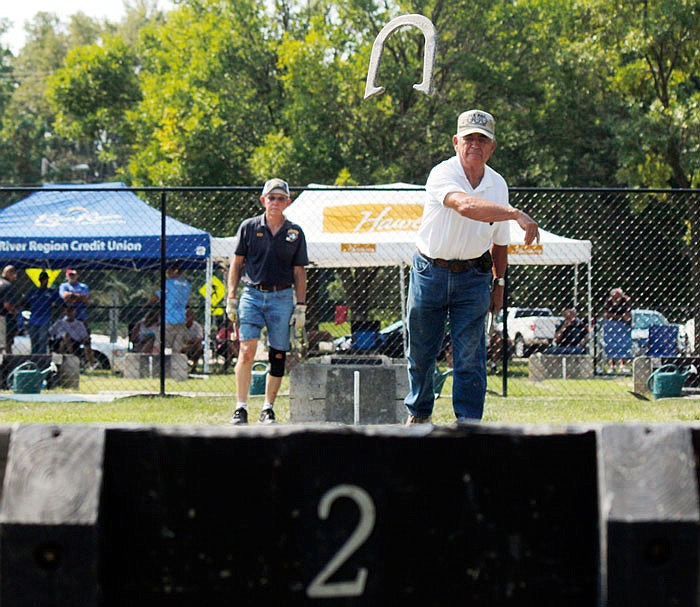The sound of jackhammers broke the tranquil air in Jefferson City's Washington Park on what should've been a peaceful Labor Day morning.
"Click-clack, click-clack, click-clack," the sound echoed throughout the park.
Men were hard at work, on this day of rest, but sounds can be deceiving. No, there were no jackhammers or buzz saws to be found, rather more than 20 participants in the 2017 Missouri State Horseshoe Pitching Championships.
The Missouri Horseshoe Pitchers Association is the largest charter in the National Horseshoe Pitching Association and has the largest sanctioned club in the United States. About 160 people from around Missouri participated in the four-day tournament. Local participants said they love competing and love the comradery of the sport.
Jefferson City resident Steve Johnson stood near a chain link fence after his first of five games smiling Monday morning. He breathed heavy, sweat soaked his chest and dry white clay caked his brown palms.
"It's warm out there," he said.
Johnson, who's retired from Harold G. Butzer Plumbing, Heating and Air Conditioning, got into horseshoes decades ago and has been throwing competitively with the state association for about 19 years.
When he chatted just before 10 a.m., Johnson was 7-0 in the championship round and 1-0 on Monday.
Johnson, the No. 2 seed in the mens open category, said he's ranked 15th in world, and participates in tournaments year round. From April-October, Johnson participates in tournaments held by the Capital City Horseshoe Club, which hosted the event for the second straight year.
In the winter, club members like Johnson play at indoor facilities in Rolla, the Lake of the Ozarks and at the National Horseshoe Pitchers Hall of Fame in Wentzville.
In all, Johnson said he probably plays in 30 tournaments. He loves the social aspect of the sport.
"This is where everybody gets together, all one good tournament," Johnson said. "I ain't never known a horseshoe pitcher I didn't like, except for one."
James Driver, another retired Jefferson Citian, stood in the shade after his second game of the day. When asked how he did, Driver replied bluntly: "I got whupped."
Driver said he threw poorly, throwing only about 30 percent of shots for ringers. His opponent, the mens open category's No. 1 seed, threw 86 percent of his shots for ringers. Driver, the No. 5 seed, sat at 5-3 in the finals. He's played horseshoes for about 50 years.
While Driver said he hates getting beat up on, the game calms him.
"It just relaxes you," Driver said. "You can enjoy the game. You can throw it by yourself and have peace of mind, whether you're throwing ringers or not."
Harrisonville resident Warren Highley, 10, won the cadet class for kids under age 12. Highley pitched with his cousin and has been throwing since he was a four-year-old when his grandma and grandpa got him into the sport.
Highley said he had fun over the weekend and doesn't want to stop anytime soon.
"I got to pitch with my cousin, and I got to pitch with someone new," he said. "I like the competition (and) meeting new people."
About 160 people ranging in age from 7-90 participated in seven categoriest. The weekend culminated with the womens championship on Sunday, and the mens championship and the mens 30-foot championship on Monday.
Pitchers threw horseshoes from distances of 20 feet, 30 feet and 40 feet, depending on their age and ability. Pitchers like Johnson and Driver threw from 40 feet in the top division.
Before each match, competitors tilled clay in pits surrounding each peg; plying it meticulously with shovels and padding the mucky grey clay.
Between games competitors sometimes took watering pots and wetted the clay to make it more pliable.
The clay may look like a little detail that separates backyard horseshoe pits from those used in state, national and international competitions. But it's crucial to ensuring the integrity of the game, according to Mel Bruemmer, vice president and treasurer of the Capital City Horseshoe Club.
"This is the thing most important to these players," Bruemmer said. "Clay is the best surface to pitch on because wherever that shoe hits, it stays. If they throw a shoe and it hits on its side, it's not going to roll, it sticks right there."

